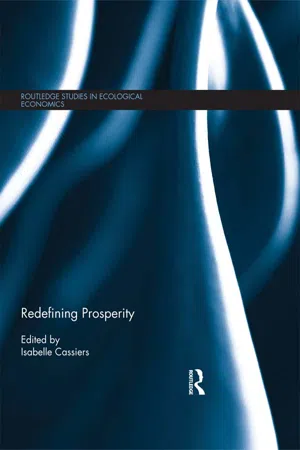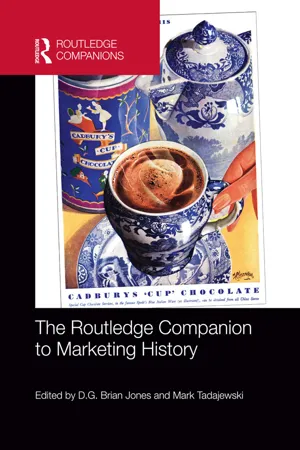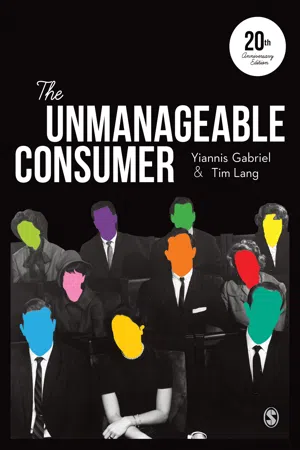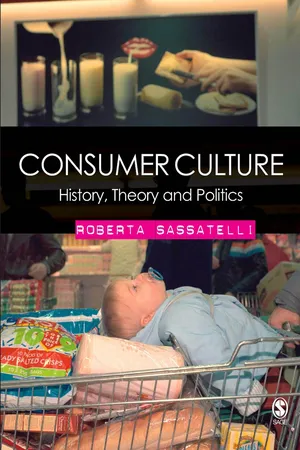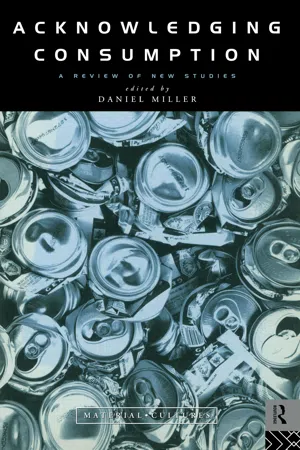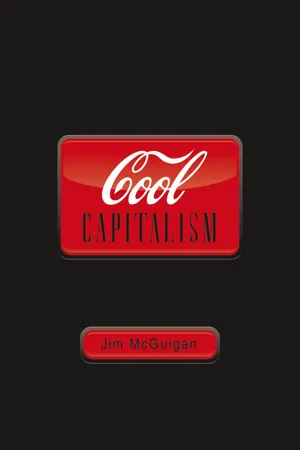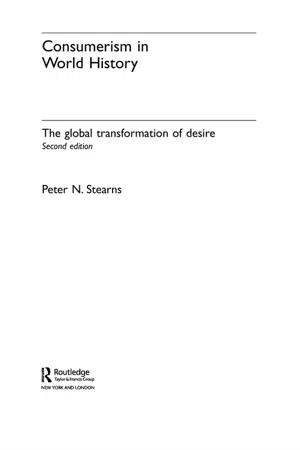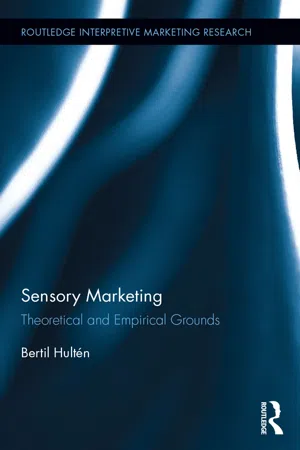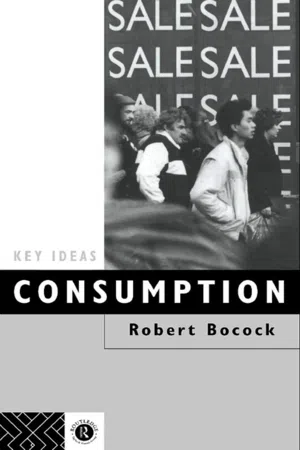History
American Consumerism
American consumerism refers to the culture of excessive purchasing and consumption that emerged in the United States, particularly after World War II. It is characterized by a focus on material possessions, mass production, and advertising. American consumerism has had a significant impact on the economy, society, and environment, shaping the way people live and interact with products and services.
Written by Perlego with AI-assistance
Related key terms
Related key terms
1 of 4
Related key terms
1 of 3
12 Key excerpts on "American Consumerism"
- eBook - ePub
Core Values in American Life
Living with Contradictions
- Arthur Neal(Author)
- 2017(Publication Date)
- Routledge(Publisher)
6Consumerism
The development of consumerism stems from the emergence of materialism, hedonism, and sensate values among all major sectors of modern society. In 1899, Thorstein Veblen (1994) saw consumerism as the defining characteristic of modern society. From his vantage point, society was divided into a series of power blocs, each motivated by materialistic values and each seeking to promote inequality in their own favor. Further, with the increased anonymity of modern life, the scope of individual respectability does not extend very far. Most of the people encountered on a daily basis are strangers, and a conspicuous display of wealth becomes one way of externalizing social worth and providing emblems of social significance. Thus, it is not the ownership of wealth that conveys social status, but the symbolic expression of a capacity to spend, to buy, or to otherwise engage in consumer-oriented behavior.The ascendance of advertising was a central component in the cultural transformation of the economic system (Lears, 1995). Business organizations recognized that their success was dependent on more than the organization of production. The rise of modern advertising depended on selling more goods at a faster rate (Fowles, 1996). As businesses grew in size, the consumers of their products became more impersonal. It became important to differentiate their product from that of their competitors.Technological advancements in the media of communication had opened up new possibilities for the dissemination of consumer information and persuasive appeals (Bogart, 2000). If millions of people were exposed to a commercial, it did not take a very large response rate for the advertisement to be successful. If only a small percent responded in a favorable way, the objective of the advertising campaign could be reached or exceeded. - eBook - ePub
- Isabelle Cassiers, Isabelle Cassiers(Authors)
- 2014(Publication Date)
- Routledge(Publisher)
The word “consumerism” designates a way of life; norms and standards for legitimate desire and for a successful life; and a means of transmitting messages, goods, and services. These cultural aspects of consumerism may vary through time and space. Broadly speaking, however, it is possible to point out several invariable characteristics which return, omnipresent and insistent, in most descriptions of the phenomenon: an individualist mode of consumption that is dependent on the market, quantitatively insatiable, invasive, hedonistic, focused on novelty, using signs rather than things, and prodigal in its use of natural and human resources. Baudrillard (1970) may be credited with drawing attention to this cultural dimension of developed capitalist societies. Second, consumerism is a mode of consumption that is both historically dated and geographically located. It has no equivalent in past human societies. It has existed as a mode of consumption within developed capitalist societies since the 1920s. It became rampant following the Second World War and the emergence of the Keynesian state, which was entirely focused on what was then called the policy of demand. Consumerism survived the dismantling of Keynesian policies at the close of the 1970s, and continues to underpin policy in the post-Ford era. Though anchored in the West, it is spreading ever more rapidly to developing Southern-hemisphere countries, and in particular to so-called “emerging economies”. 2 Three critical approaches to consumerism The critique of consumerism has existed since the birth of consumer society. It is a complex critique, and is itself part of the much broader critique of capitalism - eBook - ePub
- D.G. Brian Jones, Mark Tadajewski, D.G. Brian Jones, Mark Tadajewski(Authors)
- 2016(Publication Date)
- Routledge(Publisher)
1997 ). Gendered aspects of American consumption history include the allocation of household purchasing roles and influence, the cult of domesticity, and criticism of female materialism, among other topics and practices. Anti-consumption rhetoric includes religiously motivated and philosophical critiques of consumerism and, in practice, takes the form of environmentally virtuous behaviour, politically motivated boycotts of goods, and government policies of control and austerity. These cultural threads will be surveyed in each of the four broad eras. The present chapter format dictates that this history will be a mere overview of the topic. Gaps in the narrative appear during time periods where little historical research has been conducted.The terms ‘consumer history’ and ‘consumption history’ are deployed more or less interchangeably. Consumers here are considered people (i.e. end-users), not companies, and their consumption entails acquisition, use and disposal activities. In modern economies, acquisition largely results from shopping and buyer behaviour in a commercial marketplace. However, people can also consume goods and services from sources outside the market including nature (e.g. hunting, fishing, gathering), unpaid work (e.g. domestic activities, self-production), and public provisioning (e.g. food stamps, subsidized water and sanitation services). Consumption history is more than what consumers do; it is also about what people think, feel and say about consumption. Such intellectual history will also be addressed herein.This account of American consumption history and some of its cultural themes is largely based on secondary works including books, chapters and journal articles in American social history, as well as historical research published in the fields of marketing and consumer behaviour. It also has been informed by a small literature on consumption historiography. Historiography refers to the principles, theories and methodologies of historical writing, although it also has a second meaning as a body of literature. Contributions to consumption historiography include Fullerton (1987 ), Pollay (1987 ), Lavin and Archdeacon (1989 ), Smith and Lux (1993 ), Witkowski (1994 ), Elliott and Davies (2006 ), and Witkowski and Jones (2006). In 2011, the Journal of Historical Research in Marketing featured a special issue on ‘historical methods and historical research in marketing’ and several of its articles are very relevant to researching and writing consumer culture history (Davies, 2011 ; Fullerton, 2011 ; Pollay, 2011 - eBook - ePub
- Roxanne Hovland, Joyce M. Wolburg(Authors)
- 2014(Publication Date)
- Routledge(Publisher)
Table 2.1 are not an exhaustive list, but they at least provide a good starting point for understanding the evolution of our culture.From Then to NowThe evolution of the American economy into its present form, while not seamless, has been a continuous process over several centuries. Certainly some of the events that shaped this progression have been unprecedented and served to mark our transition toward a consumer culture in very visible ways (see Table 2.1 ). By and large, however, the process has been continuous and therefore not necessarily immediately obvious to people while it was occurring. While the changes Americans have experienced sometimes may have felt revolutionary, the progression has been one of evolution rather than revolution.The process brings to mind the old saying about putting a frog in boiling water. If you do so, the frog will jump out. But if you put him in cold water and slowly raise the temperature, he will be cooked without realizing it. This is not to say that the evolution of consumer culture is ultimately fatal. Rather, the metaphor reflects the gradual nature of the transition and illustrates the difficulty of objectively observing changes in the environment in which we are immersed.The best way to understand this evolution is by starting with the nature of today’s consumer culture. This chapter reviews the history of American consumer culture in light of the traits that characterize its present form. Beyond that, there are discernable patterns and recurring themes in the country’s transition toward today’s culture. This, in turn, leads to an examination of the role of advertising in the development of consumer culture.1. The Importance of Production: There’s Typically a Potential Surplus of Goods in Postindustrial Economies
Prior to the Industrial Revolution, American society was based on house-holding wherein most goods were produced and consumed by the same household. This system is also characterized by reciprocity (in which the exchange of goods is based on predetermined relationships and tasks) and redistribution, which is based on the will of a central authority (Norris 1980). Naturally, certain things had to be produced by skilled craftsmen, and these items would be purchased by neighbors and friends. But most of these things were made specifically for the people who intended to use them or buy or trade for them. In other words, the consumers (later to be called the market) for these goods determined which and how many goods would be produced. This is the opposite of how advanced consumer culture works, wherein which and how many goods are produced are based on production capacity and efficiency—followed by the identification of a market for them. In a society based on householding, neither the blacksmith nor the tailor was likely to have advertised an “inventory reduction” sale. As Norris points out, there was simply no need for advertising (Norris 1980). - eBook - ePub
- Yiannis Gabriel, Tim Lang(Authors)
- 2015(Publication Date)
- SAGE Publications Ltd(Publisher)
production. To be sure, a central feature of consumerism is the separation of the at times squalid circumstances of the production of commodities from their glamorized circulation and sale (Frenkel et al., 1999; Klein, 2000; Korczynski, 2001a; Korczynski, 2001b). Yet, patterns of consumption are crucially linked with developments in the nature of production. The consumer is ultimately the same person as the worker or manager now threatened by continuous mechanization of production and distribution or by the flight of capital to lower wage economies. Equally, international capital has a lot at stake in seducing the displaced peasant and exploited workers of low income countries and converting them into consumers aspiring after Western standards (e.g. Sklair, 1995; Prahalad, 2004; Seabrook, 2004).The emergence of contemporary consumerism
As a mass phenomenon, consumerism may be a distinctly 20th century one, but particular patterns of consumption have held important social meanings throughout history, something explored by a number of scholars. In a pioneering study, McKendrick explored the consumption of the affluent in the early part of the industrial revolution, when the commercialization of fashion turned the British middle class into avid spenders (McKendrick et al., 1982). Rosalind Williams looked at the rampant consumerism of the Parisian bourgeoisie and the arrival of mass consumption through the institution of department stores in the late 19th century (Williams, 1982). Mukerji went further back and examined conspicuous consumption among Elizabethan nobility, fuelled by the discovery of ‘fashion’ and the arrival of nouveaux riches (Mukerji, 1983). What sets modern consumption apart from earlier patterns is not merely the growth of spending power across social classes and strata, but, more importantly, the experience of choice - eBook - ePub
Consumer Culture
History, Theory and Politics
- Roberta Sassatelli(Author)
- 2007(Publication Date)
- SAGE Publications Ltd(Publisher)
From this point of view, the consumer society can be conceived of as a cultural response which logically follows a more fundamental economic transformation. The consumer society therefore coincides with ‘consumer culture’ or ‘consumerism’. Consumer culture is itself defined in reductive and ambiguous terms, mixing and meshing practices with representations, consumer meanings with advertising images – and indeed reducing the former to the latter, thus reducing consumption to mass culture, which is in turn depicted as a mere derivative of industrial mass production. In this way, even when consumption is the subject of analysis, it is both inappropriately and unwillingly taken back to production. A first important step towards opposing such a position has been taken by historians. Through the use of a variety of quantitative sources (from business profits and taxes, to wills, etc.) and qualitative data (descriptions of stolen objects in police reports, personal diaries, etiquette guides, etc.) historians are now able to indicate that a growth in material culture in Europe began in the early modern period and, thus, before the industrial revolution (Fairchilds 1998). A clear growth in consumption was registered above all from the second half of the 17th century and throughout the 18th century in many European nations and in different social classes – from the inhabitants of Paris (Roche 1981), to Dutch peasants (De Vries 1975), to the urban as well as rural English (Shammas 1990; Thrisk 1978; Wetherhill 1988). Of course, given the paucity of adequate sources, it is difficult to identify with certainty the pace of the growth of consumption in this period. It is also evident that the early development of modern consumption has its own particular, uneven and partial geography - eBook - ePub
- Daniel Miller(Author)
- 2005(Publication Date)
- Routledge(Publisher)
Much North American work on consumption lies within lively, and political, debates on the extent and intensity of early capitalism and capitalist mentalities (Appleby 1993). Virtuous images of frontier, pioneering and agrarian simplicity were central to post-1776 national identity (Breen 1993). Many historians worked within contemporary accounts of early Americans’ non-market ethos (Clark 1990; Henretta 1978; Merrill 1977). This image has become increasingly qualified (Lemon 1972, 1980; Pruitt 1984; Rothenberg 1988). Recent discussions emphasise that local systems of mutuality and exchange coexisted with capitalist commodity markets (Kulikoff 1989, 1993; Vickers 1990). Increasing attention to consumption also derives from work on the rising nineteenth-century middle classes (Blumin 1989; Bushman 1992; Vinovskis 1991), and on the focus of material culture studies on everyday life as well as connoisseurship (Deetz 1977; Larkin 1988; Martin 1993; Schlereth 1989a).Although definitions of ‘consumer society’ involve both material environments and mentalities, and linking the two is a common aim among historians whose specific interpretations differ considerably, in practice most writers prioritise one element over the others. The literature exhibits a persistent separation between that defining consumer culture through material objects (substantial populations with disposable income involved in markets for commodities), and that concerned with cultural representations (changes in cultural representations of goods, activities and social identities; consumption practices as skills in use). Historians stressing the early-modern period generally employ the former definition and attempt to identify what people have and how much is accessible to them, while scholars of the nineteenth century have been more concerned with the changing meaning of things, and the promotion of ‘drives to consume’. - eBook - ePub
- Jim McGuigan(Author)
- 2009(Publication Date)
- Pluto Press(Publisher)
Everywhere it seems, the consumer is triumphant. Consumers are said to dictate production; to fuel innovation; to be creating new services in advanced economies; to be driving modern politics; to have it in their power to save the environment and protect the future of the planet. Consumers embody a simple modern logic, the right to choose. Choice, the consumer’s friend, the inefficient producer’s foe, can be applied to things as diverse as soap powder, holidays, healthcare or politicians. And yet the consumer is also seen as a weak and malleable creature, easily manipulated, dependent, passive and foolish. Immersed in illusions, addicted to joyless pursuits of ever-increasing living standards, the consumer, far from being god, is a pawn, in games played in invisible boardrooms. 10 Consumption is an essential feature of human existence, fulfilling basic needs for, say, nourishment, shelter and clothing appropriate to the weather. 11 Consumerism, as the dominant ideological feature of late-capitalist culture, however, is much more controversial: it may be seen as the ultimate purpose of life or, alternatively, as distorting humanity’s relation to the natural and social worlds. Whatever the prevailing judgement, consumerism is cultural as well as economic, that is, it is imbued with meaning. In certain cases, its symbolic significance apparently transcends its strictly economic importance. Commodities are used conspicuously to say something about social identity. Historically, consumerism and conspicuous consumption have become more widely dispersed among populations in wealthier parts of the world, and have also generated aspirations for development in poorer parts of the world. Alternative explanations for how consumer desires originate, are cultivated, sustained and transformed vie with one another in wide-ranging public debates, including contributions from psychologists and sociologists of variously administrative, disinterested and critical orientation - eBook - ePub
Consumerism in World History
The Global Transformation of Desire
- Peter N. Stearns(Author)
- 2006(Publication Date)
- Routledge(Publisher)
Second: imitation of European consumerism did not mean that other societies would not generate their own causes for consumerist interest, and some of these could easily overlap with those experienced in Europe. Changes in culture, the development of new marketing methods, and status shifts for which acquiring new goods might compensate are ingredients we will see in other instances of consumerism. So though the European pattern was unique in one sense – it did not develop with any other fully consumerist model available for imitation – the causes involved deserve wider attention. But third: societies outside Europe would have their own mix of factors, that would speed, delay or shape consumerism distinctively. Even the United States, so close to European conditions in many ways, would take some distinctive turns because of unusual cultural features including a deeper commitment to religion.Modern consumerism gains greater meaning through exploring its causes. This is particularly true for the first outcropping of the phenomenon, where the causes were by definition particularly compelling and where debate among historians has centered. But attention to causes cannot be confined to this first case. Even in Western Europe, the further development of consumerism, particularly after the disruption of early industrialization, highlighted some additional factors that will be central to later analysis.Further reading
In addition to the citations in Chapter 2: Colin Campbell, The Romantic Ethic and The Spirit of Modern Consumerism (Oxford: Basil Blackwell, 1987). On eighteenth-century economics and state policy: Isabel Hull, Sexuality, State, and Civil Society in Germany, 1700–1815 (Ithaca, NY: Cornell University Press, 1996).Passage contains an image
Chapter 4
Consumerism across the Atlantic
An early imitation
It may seem strange to realize that American Consumerism was initially an imitation, but such was the case historically. The colonies that ultimately became the United States had to copy consumerism from Western Europe, and there is some debate about how fast they did so. Ultimately of course the United States would become a consumer giant, a world leader, but this chapter deals with the earlier, derivative phase. A number of factors help explain why the American colonies participated in modern consumerism with a bit of delay and hesitation.At the same time, it was noteworthy that Americans were prepared to imitate so early. As we will see, no other society seized on the consumer revolution nearly as readily. This means there is another causation challenge, in explaining why the American colonies and then the new United States were such quick studies, generating a society only slightly behind European consumer levels and interests by 1850. - eBook - ePub
Sensory Marketing
Theoretical and Empirical Grounds
- Bertil Hultén(Author)
- 2015(Publication Date)
- Routledge(Publisher)
Generally, consumption has been thought to contribute to economic, social, and cultural changes in a society’s development, which I will return to. Furthermore, it is believed that consumption fulfills a number of important social functions, where consumption in terms of demand, from an economic perspective, is believed to stimulate economic growth and affects a country’s GDP. In this context, consumption, both nationally and individually, can be regarded as signs of success and prosperity.Another influence relates to consumers from a sociological perspective, regarding what they consume as types of goods and services, which directly affects different individuals’ quality of life and lifestyles. Both individual consumption and group consumption therefore are considered to have been one of the most important ways for many individuals to create an image of themselves, of others, and of society itself, to achieve the creation of identity and self-realization.It is also considered, from a cultural perspective, that consumption is a form of collection of objects, because many people collect the artifacts that constitute the very foundation of a social culture. Hereby, consumption contributes in different ways to change both the societal culture and various sub-cultures, which was not the case earlier.Consumer Culture Theory
In the 1980s, a consumer culture theory (CCT) developed in the United States, which was an approach to understanding consumer behavior, and not just buying behavior; and it had its first theoretical starting points in terms such as aesthetics and symbolism, as well as semiotics. Among the concepts and themes that came to be introduced were the value of structuralism, symbolic interactionism, semiotic perspective, critical macro perspective, and cultural, anthropological approaches. Different methods for the interpretation of consumers’ behaviors with respect to the texts were developed, and there was an emphasis on the content and meaning of symbolism, with respect to both goods and advertisements in the form of communication in marketing.Thereafter, in the 1990s, there formed a number of European research specializations within consumer culture theory in Denmark, France, Italy, and the United Kingdom, where British scientists developed a highly critical tradition in marketing. The Danish focus was culturally influenced, and it early on came to focus on understanding cultural differences in communication to consumers in different cultures. Among the French researchers, the interpretations of consumer behavior and studies of consumption experiences were in focus, along with the postmodernist idea, which I will return to. Furthermore, the French sociological research tradition played an important role by contributing to an approach that had a critical view of marketing. - eBook - ePub
- Dr Robert Bocock, Robert Bocock(Authors)
- 2008(Publication Date)
- Routledge(Publisher)
1 The emergence of modern consumerismThe social and cultural processes surrounding consumption in western capitalism during the twentieth century have been influ-enced by earlier cultural values, carried by various social status groups into the modern capitalist period. Among these carriers of cultural values, the early rational, peaceable, bourgeois capitalists of Britain and Holland, whose world-view was analysed by the German sociologist Max Weber (1864–1920) in The Protestant Ethic and the Spirit of Capitalism, have played a crucial role of world historical significance. Their migration, sometimes forced upon them, across the Atlantic, laid the basis of the modern United States of America—the social formation which has come to epitomise the modern consumer’s dreamland, or heaven on earth. The analysis Weber provided of this group, the early rational, Calvinist capitalists of the seventeenth century, will be discussed briefly here, before looking at later changes to this cultural patterning underpinning rational capitalism in the eighteenth century.The changes in patterns of consumption during late nineteenthand early twentiethcentury capitalism, up to the outbreak of the First World War in 1914, will be discussed in the light of the sociology of consumption from Veblen and of the newly emerging metropolitan life-style analysed by Simmel. The period of the two world wars, and the intervening economic recession and depression of the 1920s and 1930s, was one in which capitalism failed to deliver consumer goods to the working classes. Reflecting this bleak and violent economic and political period, sociologists concentrated on other issues, such as the appeal of fascism, rather than upon consumption.The story of the social and cultural role of consumption in modern, western capitalism continued with the growth of what was often called at the time, that is in the 1950s and 1960s, ‘the growth of mass consumption’. There were some interesting features of mass consumption which have been seen as distinctive of the period from the early 1950s up to the late 1960s. From the 1970s to the 1980s, some writers have argued that a new, even ‘post-modern’ pattern of consumption developed. The significance of this will be explored in the last part of this chapter. - eBook - ePub
- John Storey(Author)
- 2017(Publication Date)
- Routledge(Publisher)
8Consumerism and Consumer SocietyAll the previous chapters have focused on different ways to think about consumption. In this chapter we will explore debates around consumerism and consumer society. I will begin with a brief discussion of the difference between consumption and consumerism, as too often the terms are mistakenly used interchangeably. This will be followed by a critical engagement with the birth of consumer society, anti-consumerism, advertising and commodity activism.Consumption and consumerism
Karl Marx distinguishes between ‘production in general’ and specific historical modes of production. As he explains it, production in general ‘is common to all social conditions, that is without historic character, human ’ (1973: 320). But the human need to produce is always located historically in a particular mode of production: i.e. humans have always produced but how they produce is always historically situated. In other words, there is a difference between a slave mode of production and a capitalist mode of production. If we think of this in terms of consumption, we arrive at similar conclusions: there is ‘consumption in general’ and there are specific modes of consumption. Humans have always consumed, but in different historical periods we have consumed differently. As Marx points out,Hunger is hunger, but the hunger gratified by cooked meat eaten with a knife and fork is a different hunger from that which bolts down raw meat with the aid of hand, nail and tooth. Production thus produces not only the object but also the manner of consumption, not only objectively but also subjectively. Production thus creates the consumer (1973: 92).Our contemporary attitudes to consumption, our consumption practices and our consumption desires, have developed alongside the historical development of capitalism as a mode of production. Put simply, consumerism is the capitalist version of consumption; it is a particular historical mode of consumption unique to this mode of production. Consumerism is not, therefore, just consumption, it is increasingly a way of life, producing a sense – what Gramsci would call a ‘common sense’ (1971) – that who we are is defined and expressed through the commodities we consume. Consumerism is a practice that seeks to define people first and foremost as consumers. Moreover, it is a way of life that is dependent on more of the same – i.e. more capitalism.1
Index pages curate the most relevant extracts from our library of academic textbooks. They’ve been created using an in-house natural language model (NLM), each adding context and meaning to key research topics.
Explore more topic indexes
Explore more topic indexes
1 of 6
Explore more topic indexes
1 of 4

